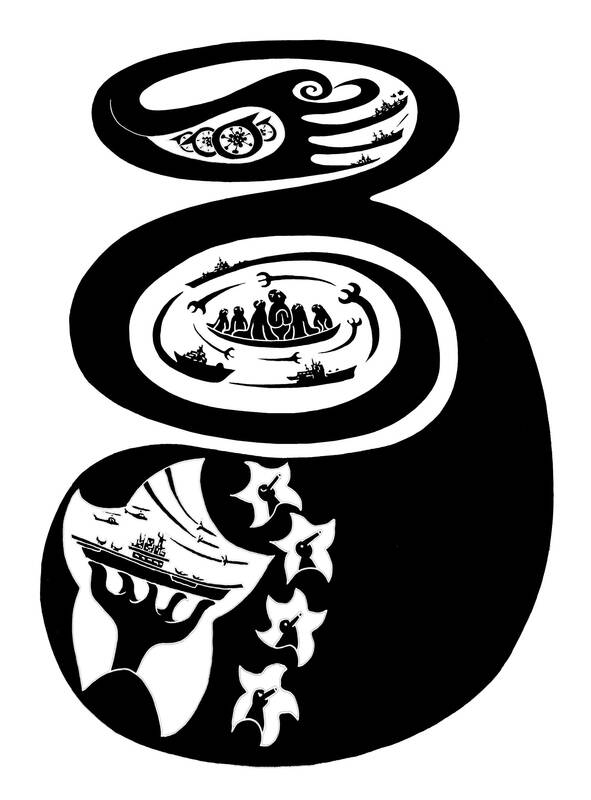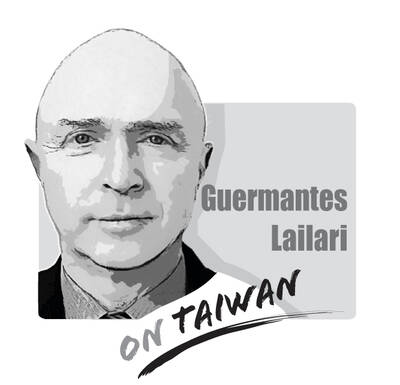In the past two weeks, the Chinese People’s Liberation Army (PLA) conducted live-fire naval drills in international waters off Australia, New Zealand and Vietnam, and shooting drills in the Taiwan Strait. The exercises are a sign of China’s growing confidence as a maritime power.
The show of military might is a signal to its closest neighbors that they would have to start relying on each other, or boost their own defense capabilities far more than they originally thought. They cannot expect to depend on the US for backup.
US President Donald Trump has a message from the world: Do things for yourself first, and then we might help you out — if it suits us. In just the first month of his term, his team have told Europe that it needs to pay more for its own security, lectured allies on democracy and pulled funding from US aid and development programs.

Illustration: Mountain People
As Washington retreats from the international stage, Beijing is advancing — militarily at least. China now has the world’s largest maritime fighting force, with 234 vessels compared with the US Navy’s 219. It is also producing more warships at its shipyards at a faster pace; about 70 percent were launched after 2010, compared with 25 percent for the US Navy.
While China’s vessels are not necessarily superior — yet — the US Office of Naval Intelligence assessed in 2020 that its ships were increasingly of comparable quality. Last year, Beijing also passed the milestone of achieving more than 50 percent of the US Navy’s firepower in vertical launch system missile cells on its surface ships. That gives Beijing the capability to take more advanced weapons systems further out into the oceans.
The Chinese drills took place in international waters, and are permissible under international law. The US Navy traverses the world’s oceans, including the Taiwan Strait and the South China Sea, along with partners and allies. Freedom of navigation, and what is known as “right of innocent passage,” are central tenants of the rules-based order.
Those principles bring with them an implicit contract — a polite adherence to international norms, but Beijing did not give any notice about the drills in the Taiwan Strait or the Tasman Sea. Australia found out about them from a commercial pilot over radio communications.
The message from China is hiding in plain sight, said Anne-Marie Brady, professor of political science and international relations at New Zealand’s University of Canterbury.
“China is now a sea power in the Pacific. They want to rule the waves,” she said.
The intent was clear — its actions disrupted commercial air travel in the Tasman Sea, and were a show of intimidation to smaller opponents.
Taiwan has condemned the exercises, saying they severely disrupt regional peace and stability, and are blatant acts of provocation. The democracy understands Beijing’s military might better than most. Warships and planes from China cross the median line of the Taiwan Strait on an almost daily basis, fatiguing Taipei’s defense forces.
However, the scale of the maneuvers is different. What they are partly conveying is that the world is no longer dealing with simply a superpower in East Asia, but rather a “great maritime power” whose presence is to be more ubiquitous, Elena Collinson and Corey Lee Bell — head of analysis and a researcher respectively at the Australia-China Relations Institute, University of Technology Sydney — said
Resistance, Beijing appears to be saying, is futile. That means we should anticipate China to project power in places far beyond domains subject to its territorial claims. Trump is making things easier for Beijing. Under previous administrations, the US has said it is a Pacific nation, and built a network of partners in the Indo-Pacific region to help maintain influence. Under the new president, none of this is guaranteed. He has imposed tariffs on allies, and has tied potential security guarantees to economic interests.
That has left many in Asia with the impression that “America First” means “America Alone” — and that means they are on their own. Asian countries would have to invest more in their own defense as Europe and the UK are also considering.
Some of this is already happening. Taiwan and Japan have announced plans to boost their defense budgets. Singapore and India continue to make it a priority, while Australia and New Zealand are weighing their options.
Still, bigger defense spending is no guarantee of a secure military alliance with the US. Washington risks missing the bigger picture with this approach. The PLA has long had aspirations to extend its reach. By conducting live-fire military exercises in quick succession throughout the Indo-Pacific region, it is showing that it is able to build out that capability.
China is getting militarily stronger in an age of great power adventurism. The question is whether the US would do anything about it.
Karishma Vaswani is a Bloomberg Opinion columnist covering Asia politics with a special focus on China. Previously, she was the BBC’s lead Asia presenter and worked for the BBC across Asia and South Asia for two decades. This column does not necessarily reflect the opinion of the editorial board or Bloomberg LP and its owners.

A foreign colleague of mine asked me recently, “What is a safe distance from potential People’s Liberation Army (PLA) Rocket Force’s (PLARF) Taiwan targets?” This article will answer this question and help people living in Taiwan have a deeper understanding of the threat. Why is it important to understand PLA/PLARF targeting strategy? According to RAND analysis, the PLA’s “systems destruction warfare” focuses on crippling an adversary’s operational system by targeting its networks, especially leadership, command and control (C2) nodes, sensors, and information hubs. Admiral Samuel Paparo, commander of US Indo-Pacific Command, noted in his 15 May 2025 Sedona Forum keynote speech that, as
Chinese Nationalist Party (KMT) Chairman Eric Chu (朱立倫) last week announced that the KMT was launching “Operation Patriot” in response to an unprecedented massive campaign to recall 31 KMT legislators. However, his action has also raised questions and doubts: Are these so-called “patriots” pledging allegiance to the country or to the party? While all KMT-proposed campaigns to recall Democratic Progressive Party (DPP) lawmakers have failed, and a growing number of local KMT chapter personnel have been indicted for allegedly forging petition signatures, media reports said that at least 26 recall motions against KMT legislators have passed the second signature threshold
The Central Election Commission (CEC) on Friday announced that recall motions targeting 24 Chinese Nationalist Party (KMT) lawmakers and Hsinchu Mayor Ann Kao (高虹安) have been approved, and that a recall vote would take place on July 26. Of the recall motions against 35 KMT legislators, 31 were reviewed by the CEC after they exceeded the second-phase signature thresholds. Twenty-four were approved, five were asked to submit additional signatures to make up for invalid ones and two are still being reviewed. The mass recall vote targeting so many lawmakers at once is unprecedented in Taiwan’s political history. If the KMT loses more
In a world increasingly defined by unpredictability, two actors stand out as islands of stability: Europe and Taiwan. One, a sprawling union of democracies, but under immense pressure, grappling with a geopolitical reality it was not originally designed for. The other, a vibrant, resilient democracy thriving as a technological global leader, but living under a growing existential threat. In response to rising uncertainties, they are both seeking resilience and learning to better position themselves. It is now time they recognize each other not just as partners of convenience, but as strategic and indispensable lifelines. The US, long seen as the anchor